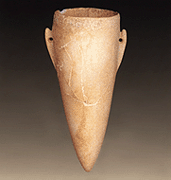 


The settlement of Kephala is situated on a rocky promontory, in the northern part of Kea island, and is the only open settlement, in which the Final Neolithic of the Cyclades is fully represented. The similarity of cultural elements at Kephala with its counterparts from settlements in Attica and Aegina led investigators to classify a part of the long Final Neolithic Period in southern Greece with the term Attica-Kephala culture. |

Excavations at Kephala (1960-1966, 1973) revealed a settlement with small rectangular stone buildings, built very close to each another. The Neolithic community of Kephala numbered 45-80 inhabitants and had a farming/stock-rearing character. Cereals, sheep and goats, cattle, pigs, but also fish were the staples in their diet. Pottery, weaving and basketry (imprints on vase bases), as well as the manufacture of tools of Melian obsidian and excellent marble vases were some of the productive activities of the inhabitants of Kephala. The in situ practice of metalworking is remarkable as testified by fragments of clay crucibles and copper artefacts, such as needles and tools. It is assumed that copper used at Kephala originated from Lavrion in eastern Attica. On the slope of the promontory, a little lower than the settlement, a cemetery, stretching over two different terraces, has been unearthed. It contains 40 circular or rectangular graves, dug in the ground. Their walls were built with stones, while their open side was sealed with slate slats. Among the graves there are make-shift partition walls. It has been calculated that in this cemetery at least 65 dead were buried, among them children and infants, and that it was in use for 60-150 years. The settlement at Kephala, was suddenly abandoned for an unknown reason and it is assumed that the community moved to the site Paoura of Kea. |